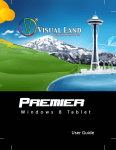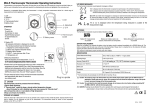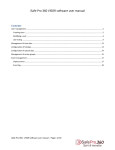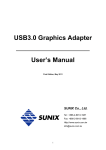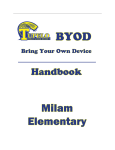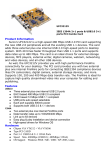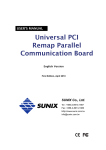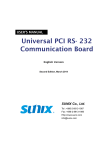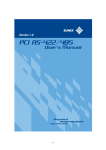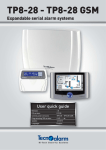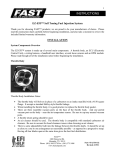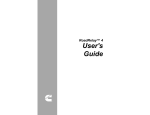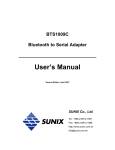Download User`s Manual
Transcript
Manual Download Please visit SUNIX website http://www.sunix.com by searching keyword “iSafe” or “KEY-256UN1” for detail. 1 User’s Manual Copyright Copyright© 2014 SUNIX Co., Ltd. All Rights Reserved. No part of this publication may be reproduced, transcribed, stored in a retrieval system, translated into any language, or transmitted in any from or by any means, photocopying, manual, or otherwise, without prior written permission from SUNIX Co., Ltd. Disclaimer SUNIX Co., Ltd. Shall not be liable for any incidental or consequential damages resulting from the performance or use of this equipment. SUNIX Co., Ltd. makes no representations or warranties regarding the contents of this manual. Information in this manual has been carefully checked for reliability; however, no guarantee is given as to the correctness of this content. In the interest of continued product improvement, this company reserves the right to revise the manual or include change in the specifications of the product described within it at any time without notice and without obligation to notify any person of such revision or changes. The information contained in this manual is provided for general use by the customers. Trademarks SUNIX is a registered trademark of SUNIX Co., Ltd. Other registered marks used herein are for identification purposes only and may be trademarks of their respective owners. Safety Information 1. Keep this User’s Manual for future reference. 2. Always read the safety information carefully. 3. Keep this equipment away from direct sunlight, or in humid or damp places. 4. Do not place this equipment in an unstable position, or on vibrating surface before setting it up. 5. Do not use or place this equipment near magnetic fields, televisions, or radios to avoid electronic interface that affects device performance. 6. Do not attempt to disassemble or repair the equipment or the warranty would be useless. 7. To avoid damaging your system and equipment, please make sure that your computer is off before you install the product. 2 Regulatory Compliance FCC Class B Declaration This equipment has been tested and found to comply with the limits for a Class B digital device, pursuant to part 15 of the FCC rules. These limits are designed to provide reasonable protection against harmful interference when the equipment is operated in a commercial environment. This equipment generates, uses and can radiate radio frequency energy and, if not installed and used in accordance with the instruction manual, may cause harmful interference to radio communications. Operation of this equipment in a residential area is likely to cause harmful interference in which case the user will be required to correct the interference at his own expense. Modifications not authorized by the manufacturer may void users authority to operate this device. This equipment meets the requirements of EC Electromagnetic Compatibility Directive (2004/108/EC) For EU (European Union) member users: According to the WEEE (Waste electrical and electronic equipment) Directive, do not dispose of this product as household waste or commercial waste. Waste electrical and electronic equipment should be appropriately collected and recycled as required by practices established for your country. For information on recycling of this product, please contact your local authorities, your household waste disposal service or the shop where you purchased the product. 3 Table of Contents Chapter 1 Introduction 1.1 Features.......................................................................................................................................... 6 1.2 System Requirements .................................................................................................................... 6 1.3 Support Language .......................................................................................................................... 6 1.4 Getting Started ............................................................................................................................... 7 1.5 iSafe SecureKey Main Panel ........................................................................................................... 8 1.6 Exit / Uninstall Pogram................................................................................................................. 10 Chapter 2 Windows OS- iSafe 2.1 PC Lock ......................................................................................................................................... 12 2.2 iSafe Key Configuration ................................................................................................................ 12 2.3 How to Use ................................................................................................................................... 13 2.4 Cloud Encryption .......................................................................................................................... 14 2.5 First Time Configuration .............................................................................................................. 15 2.6 How to Use ................................................................................................................................... 17 2.7 Security Disk ................................................................................................................................. 19 2.8 First Time Configuration .............................................................................................................. 19 2.9 How to Use ................................................................................................................................... 22 2.10 Add Security Folder .................................................................................................................... 23 2.11 First Time Configuration ............................................................................................................ 23 2.12 How to Use ................................................................................................................................. 24 2.13 File Encryption/ Decryption ....................................................................................................... 25 2.14 File Encryption for Share ............................................................................................................ 26 2.15 iSafe SecureKey Mobile App ...................................................................................................... 28 Chapter 3 Android Device 3.1 iSafeSecureKeyViewer ................................................................................................................. 30 3.2 First Time Configuration .............................................................................................................. 30 3.3 How to Use - Dropbox/GoogleDrive ............................................................................................ 31 3.4 How to UseOneDrive ................................................................................................................... 32 3.5 How to Use Box ............................................................................................................................ 33 3.6 Contact Information ..................................................................................................................... 35 4 1. Introduction Thank you for purchasing and using iSafe SecureKey! The iSafe SecureKey application has been pre-loaded in the iSafe Key. Follow the instructions to install the iSafe SecureKey application. iSafe SecureKey will provide the best protection for your cloud storage and your computer. You can also browse and edit the encrypted files in your cloud storage via Android phones. *Important Notice*: If one key is lost, there is a backup key. However, we recommend that you back up all encrypted files in unencrypted form, in case you lose the backup key as well. It is impossible to decrypt files if both keys are lost. We are not responsible for any lost, stolen, or damaged iSafe keys. It is impossible to replace iSafe keys, so therefore we do not replace any lost, stolen, or damaged iSafe keys. Warning: iSafe is waterproof, however, please do not immediately plug the iSafe into the computer after contact with water. The computer can be damaged if exposed to water. The following topics covered in this chapter: 1.1 Features 1.2 System Requirements 1.3 Support Language 1.4 Getting Started 1.5 iSafe SecureKey Main Panel 1.6 Exit / Uninstall program 5 1.1 Features ■ PC Lock provides screen and keyboard lock functions. Once the iSafe Key device is unplugged from the computer, the computer’s screen and keyboard will immediately lock to prevent others from using it. ■ Cloud Encryption can automatically encrypt files dropped in the selected folder, the encrypted files will be automatically synchronized to the cloud storage. ■ You can browse and edit your encrypted files in cloud storage via your Android phone. After editing a file, you can choose to encrypt the file and upload the file to the cloud on your Android phone. ■ Security Disk creates a virtual disk drive, which is encrypted by AES 256Bit codes. Once you log off the virtual disk drive or unplug the iSafe Key device, the virtual drive will hide immediately. ■ 「File Encryption」 and 「File Decryption」 can protect files and folders on your and computer for your personal privacy. ■ Add Security Folder function, automatically encrypts the file(s) dropped in the specified folder. ■ If you are not allowed to install and use the iSafe SecureKey in an access limited or public computer, you can still access your encrypted file(s) stored in Cloud by the iSafe Key. 1.2 System Requirements ■ ■ PC or Notebook: Windows 7/ 8/8.1 32 or 64Bit Android device: OS 4.0 and above 1.3 Support Language The application will display the appropriate language interface according to your language settings of the operating system. iSafe SecureKey application supports three languages—Simplified Chinese, Traditional Chinese and English. 6 1.4 Getting Started Follow the instructions to install the iSafe SecureKey application: 1. When iSafe SecureKey is plugged into the computer, iSafe SecureKey software will automatically launch. 2. When the AutoPlay window pops up, click "Run SPStarter.exe". 3. If the “User Account Control” window pops up, click“Yes”to continue. 7 4. After the application is installed successfully, please restart the computer. 1.5 iSafe SecureKey Main Panel Click iSafe SecureKey icon ( ) in the taskbar to launch the main panel. iSafe SecureKey main panel: 8 Menu Description 1 Main Menu : Click the icon to open the function. Click the panel to configure the settings for first time use. 2 Minimize : Minimizes panel 3 Close: Closes the panel. 4 Company Information: Company and Web site information. 5 Always on Top : Enable to keep the panel to always stay on top. If iSafe SecureKey panel is hidden, you can left click the icon ( ) in the taskbar to launch the iSafe SecureKey panel again. Right clicking the icon ( ) on the taskbar opens the function menu, Left click the option which you want to launch. 9 1.6 Exit / Uninstall Pogram 1. Exit : Click“Exit”on the function menu to exit the program. 2. Uninstall: Please note that if you uninstall iSafe SecureKey application, the program and configuration settings will be removed from your computer. 10 2. iSafe SecureKey on Microsoft Windows This chapter includes information about iSafe SecureKey on Microsoft Windows. The following topics are covered: 2.1 PC Lock - 2.2 iSafe Key Configuration - 2.3 How to Use 2.4 Cloud Encryption - 2.5 First Time Configuration - 2.6 How to Use 2.7 Security Disk - 2.8 First Time Configuration - 2.9 How to Use 2.10 Add Security Folder - 2.11 First Time Configuration - 2.12 How to Use 2.13 File Encryption/ Decryption 2.14 File Encryption for Share 2.15 iSafe SecureKey Mobile App 11 2.1 PC Lock Once iSafe Key is unplugged from the computer, 「PC Lock」will immediately lock the screen and keyboard usage to stop illegal access from others. 2.2 iSafe Key Configuration Enable「PC Lock」function: Click the 「PC Lock」 icon to open the PC Lock settings page. Once you select “Lock my screen” and enter your windows login password, the PC Lock function will be enabled. 12 2.3 How to Use If the 「PC Lock」 function is enabled, it will lock the computer once the iSafe Key is unplugged from the computer. Plug the iSafe Key back in and enter the login password to unlock the screen. To automatically login to the computer without user intervention (password key in) after the key is re-plugged. Please enable “Auto logon after screen unlocks” option and enter your Windows login password, this will activate the Automatic login function. Note: You still have to enter the Windows login password after restarting the computer. 13 Cancel 「PC Lock」 feature: Please uncheck the option of “Lock my screen,” then click “OK” to disable the 「PC Lock」. 2.4 Cloud Encryption 「 Cloud Encryption 」 can automatically encrypt files in your specified folder, and immediately synchronize the encrypted files to the cloud storage. 「 Cloud Encryption 」 supports four cloud storage tools (Dropbox /OneDrive/Google Drive/Box). To use the 「Cloud Encryption」 feature, please install at least one of the cloud tools in your computer. The 「Cloud Encryption」 feature can support multiple cloud tools at the same time. 14 2.5 First Time Configuration Click 「Cloud Encryption」 icon on the panel to open the settings window: 1. Select cloud storage type (Dropbox / OneDrive / Google Drive/ Box) which you have already installed in your computer. 15 2. Click to select the folder you want to apply the 「Cloud Encryption」, and then press "OK" button. Note : If you use Dropbox for Cloud storage, the name of the local security folder must be “AES Key Security Folder”. There is no restriction for other Cloud storage tools. 3. Select Cloud Storage Client Folder: iSafe Key will use the default cloud storage path. If the default path is not correct, please select the right cloud storage path, and then click the "OK" button. 16 2.6 How to Use After the entire configuration is set, once the files are added to the specified directory, they will be automatically encrypted and synchronized to the Cloud storage. Note: The file you directly dropped to the cloud storage directory will not be encrypted or synchronized to the local directory. 1. Right-Click on the file that you want to copy and paste to the Local Security Folder and the file will be automatically encrypted and synchronized to the Cloud Storage Client Folder. 2. Any file deleted in the Local Security Folder, will be automatically removed from the cloud storage drive. Note: Always delete file(s) in the Local Security Folder. iSafe Key only supports file synchronization from Local Security Folder to Cloud Storage Client Folder. If you delete file(s) in Cloud Storage Client Folder, but keep the file(s) in the Local Security Folder, those file(s) will be recovered and synchronized to the Cloud Storage later. 17 If you want to open an encrypted file, double-click the file and it will be decrypted and open for editing. After closing the file, it will be automatically encrypted. Note: If you fail to open an encrypted file by double-clicking, please right-click the file and select [File decryption], and then the file will open. 18 If you use one iSafe Key to encrypt file(s), you cannot open the file(s) with the other iSafe key. If the iSafe Key is not plugged in, you can not open the file either. Delete Cloud Encryption settings: Choose the Cloud Encryption setting you want to cancel, click the "delete" button, then click the "OK" button, the Cloud Encryption settings will be removed. 2.7 Security Disk Security Disk creates a virtual disk drive, which is encrypted by AES 256Bit codes. Once you log off the virtual disk drive or unplug the iSafe Key device, the virtual drive will hide immediately. Unless you re-plugin the iSafe key, the virtual drive will not show up. 2.8 First Time Configuration Left Click 「Security Disk」 icon on the main panel to open Security Disk Setting window. 1. You must configure the virtual disk drive. You can click to choose a disk, Flash drive or portable hard drive as your virtual disk drive. 19 You can adjust the virtual disk space by clicking the drag bar, or enter the volume for your virtual disk capacity. In addition, you can change the name of your virtual disk. The maximum length of the virtual disk name is 9 English characters. 2. Click the "OK" button, do not remove Source Disk while the process is running. 20 3. If the security disk is created successfully, a message dialog will show up. Click the "OK" button to enter your virtual disk drive. The security disk can be found in 「My Computer」as well. 21 2.9 How to Use Security Disk is successfully created, once you unplug the iSafe Key device, the virtual disk drive will be immediately hidden; plugin the iSafe Key device, the virtual disk drive will appear. Logout : Logout the security disk, the virtual disk will disappear. Open up : Open up the security disk, you can click "Open up" to open the virtual disk. Resize : To resize the security disk, you must delete the existing disk before creating the new one. Click "Delete" to remove your existing virtual disk from your computer. A warning message window will show up, click "Yes" to continue or “No” to leave the operation. 22 2.10 Add Security Folder Automatically encrypt the file(s) which are dropped into the security folder. 2.11 First Time Configuration Left Click 「Add Security Folder」 on the main panel to open the settings window. Click to choose the folder path and enter the folder name, then click "OK" to store the setting. You can add multiple Security Folders by choosing a new path or entering a new folder name . 23 2.12 How to Use After the setup is done, you can drag or copy your personal files to the security folder, the files will be automatically encrypted. If you want to open the encrypted file, double-click the file to decrypt for reading and editing. Note: If you fail to read the decrypted file by double-clicking, please right-click the file and select [File decryption], then the file will be decrypted and will open. Delete Add Security Folder Settings: Click to select the path in drop-down menu, click "delete" to remove the settings and all files in the Security Folder. 24 2.13 File Encryption/ Decryption 「File Encryption」and 「File Decryption」 can secure important files and folders on your computer for your personal privacy. 1. Right-click on a file or several files to select 「File Encryption」. After a file is successfully encrypted, a lock 25 will be added to the file icon. 2. File Decryption If you want to read the encrypted file, simply double-click on the file or right-click to select 「File Decryption」 and the program will decrypt file. [Note] You should use the same iSafe Key device to decrypt a file as the one you used to encrypt the file. 2.14 File Encryption for Share If you want to share encrypted files with your friends for reading, you can use the 「File Encryption for share」but any other person who wants to read the encrypted file also needs to install the iSafe Key application. 1. Right click on the file you want to share and choose 「File Encryption For Share」. 26 2. Setup a password for encryption sharing and then click “OK " to encrypt the file. After a file is successfully encrypted, a lock will be added to the file icon. 3. To read the shared encrypted files on a different computer, you must have your iSafe Key plugged to your computer, right-click the encrypted file, select 「File Decryption」or double-click the encrypted file, enter the correct password, and then the file will be automatically decrypted. 27 2.15 iSafe SecureKey Mobile App If you want to access encrypted files stored in cloud/USB drives on a public PC, which you don’t have the user privilege to install iSafe SecureKey, please take the following steps: 1. Insert your iSafe SecureKey to the USB port on the public PC and open the iSafe SecureKey window. 2. Download the encrypted file you want to read on the public PC, then drag & drop it to the “Open”button, as shown in the chart below: 3. After reading the downloaded files, you can permanently delete them from the public PC by dragging the file to the “Delete” button, as shown in the chart below. 28 3. Android Device The following topics covered in this chapter: 3.1 iSafeSecureKeyViewer 3.2 First Time Configuration 3.3 How to Use - Dropbox/GoogleDrive 3.4 How to UseOneDrive 3.5 How to Use Box 3.6 Contact Information 29 3.1 iSafeSecureKeyViewer You can browse your encrypted files in your cloud storage disk via your Android phone. After saving the file, the file will be encrypted and uploaded to the cloud drive (Dropbox/Google Drive/OneDrive) via your Android phone. 3.2 First Time Configuration 1. You can search the iSafeSecureKeyViewer.apk from Google Play and install the app to your Android device. Please install one of the cloud storage tools in your computer before executing the function. All of the four cloud storage tools can be executed, at first you have to install the cloud software program which you want to execute on your computer. 2. After iSafeSecureKeyViewer is successfully installed, please install one of the cloud storage tools (Dropbox/Google Drive/OneDrive/Box) on your Android phone. 30 3.3 How to Use - Dropbox/GoogleDrive If you want to read the file which was encrypted by the iSafe Key:Take Dropbox for example: Click the file encrypted by the iSafe Key (「~ODKE」) as shown in the following red box. Refer to the following prompt to decrypt the file. 31 3.4 How to UseOneDrive If you want to read the file which was encrypted by iSafe Keyon OneDrive: 1. Select the file you want to read, click icon, and complete action using iSafeSecureKeyViewer. 2. Refer to the following prompt to encrypt and read the file. 32 3.5 How to Use Box If you want to read a file stored on Box drive, you have to download it to your cell phone first and open it with iSafe SecureKey: 1. Select the file you want to read and click “Download”. 2. Select the target folder on your cell phone . 33 3. Select the file in the target folder and share with iSafeSecurekeyViewer. 4. Refer to the following prompt to encrypt and read the file. 34 3.6 Contact Information Customer satisfaction is our number one concern, and to ensure that customers receive the full benefit of our products, SUNIX services have been set up to provide technical support, driver updates, product information, and user’s manual updates. The following services are provided E-mail for technical support ................................... [email protected] World Wide Web (WWW) Site for product information: ............................http://www.sunix.com 35




































